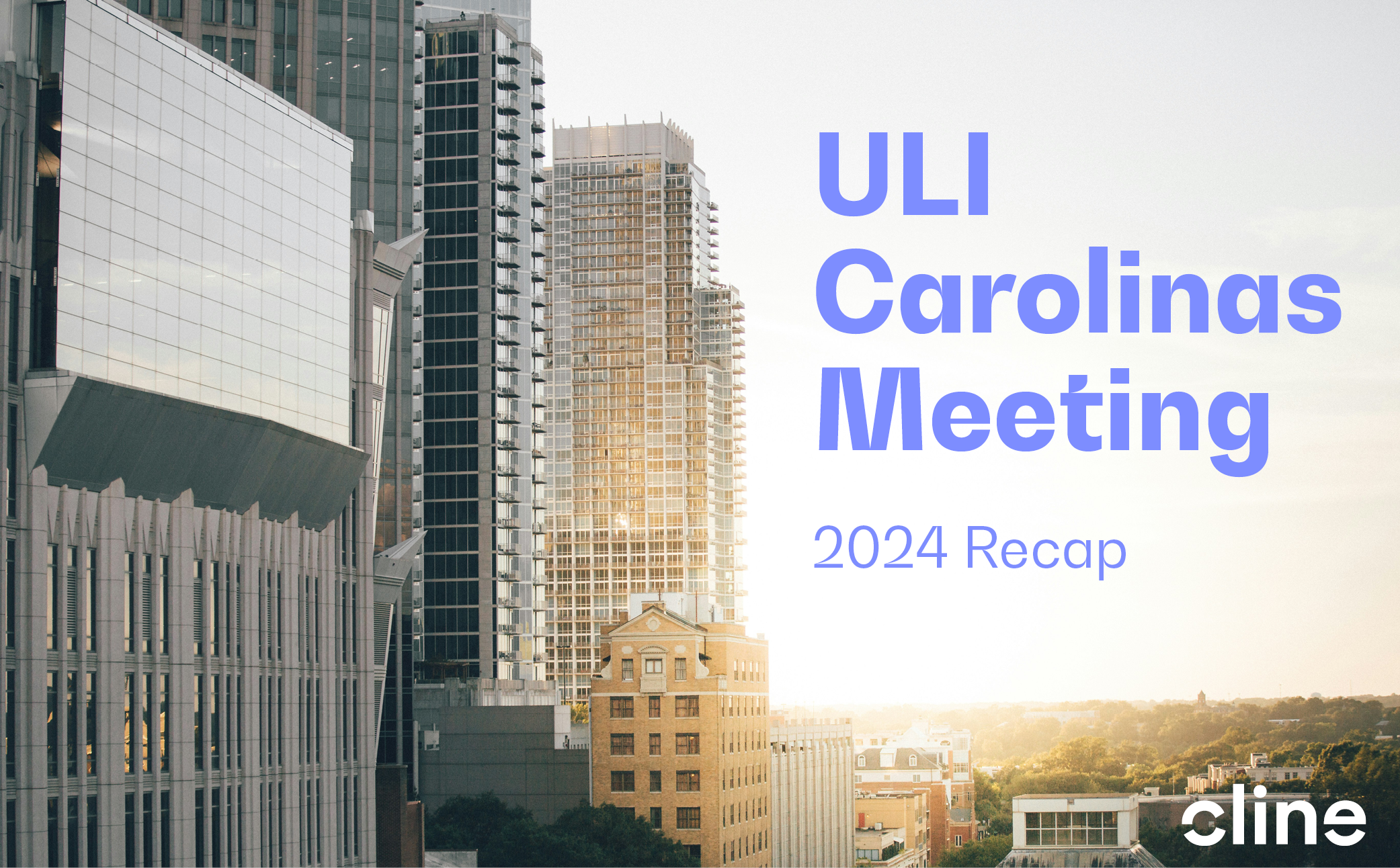Trends & Strategies in Urban Development & Multifamily Markets

On February 22-23, 2024, the ULI Carolinas meeting took place at the Charlotte Convention Center, drawing in professionals from across the region to discuss the latest trends and innovations in urban development. Cline was well-represented with several attendees who participated in various sessions. Among them, Audrey Krenitsky and Josh Karrick, took a moment to share their keen insights and reflections on the conference.
Real Deals in Today’s Capital Markets
- Interest Rates. Short-term interest rates are expected to be high initially in 2024, leading to a slow start for the year. However, there’s optimism that long-term rates, crucial for loan underwriting in multifamily developments, will become more favorable. As the architect, we can provide insights into how design decisions might impact project costs and align with budget constraints while considering potential fluctuations in long-term interest rates affecting loan underwriting. We can balance foundational design principles and investment-minded decision making to help our clients.
- Multifamily Market Stability. Unlike the significant shifts witnessed in office spaces, how people need and utilize housing has generally remained the same, suggesting stability in demand for multifamily housing and a reliable market for developers. Firm’s that work with developers such as Cline are adept at analyzing housing trends and user behaviors to inform design solutions that meet current and future demands, ensuring the project’s market viability.
- Rental Demand. The cost disparity between owning and renting a home is significant, contributing to the sustained demand for rental housing. Developers can capitalize by focusing on multifamily rental projects to meet the market’s demand. As architects, residential buildings are the most personal spaces we design. Where we live shapes how we live. That’s why it is imperative to imagine the lives people want to lead, their needs and desires, and design places that make it attainable.
- Construction Slowdown. New construction in the multifamily sector has slowed in the past year, suggesting fewer projects will be delivered in early 2026. Developers who can position themselves to deliver projects around this time will likely benefit from reduced competition and a higher demand. We can strategize project timelines to optimize delivery and navigate project complexities to find efficiencies, giving developers a competitive edge.
Transforming Urban Centers to Central Social Districts
- Flexible & Adaptable Approach. Urban centers thrive by embracing flexibility and adaptability in various aspects, including architectural design, public spaces, and the development of “hybrid” neighborhoods. Utilizing this approach enables cities to respond effectively to reduced office occupancy rates and economic challenges, fostering resilience and innovation. By prioritizing flexibility and adaptability in design, we can use AHJ design and development requirements as inspiration for new creative expressions in urban centers.
- A Focus on Placemaking. Activating urban centers requires a focus on placemaking and providing opportunities for recreation. By creating fun and exciting avenues, cities can attract both residents and visitors, stimulating commerce and fostering community growth. We can design attractive parks, plazas, and streetscapes that encourage social interaction and recreational activities. Striving to incorporate amenities, such as outdoor seating and art installations, enhances the overall experience and fosters community vitality.
- Central Business Districts. Outreach and engagement are key strategies in understanding the diverse patronage of Central Business Districts (CBDs), which includes not only workers and residents, but also nearby neighborhoods and local tourists. By incorporating community input, cities can ensure that development initiatives are inclusive, sustainable, and beneficial to all stakeholders. It is important that we facilitate community engagement throughout the design and development process. This involves actively seeking input from residents, businesses, and other stakeholders to understand their needs and aspirations for the project. By incorporating community feedback into the design process, we ensure that urban developments reflect the values and priorities of the people who will use and inhabit them.
MEET THE CONTRIBUTORS
Audrey Krenitsky
Audrey is the Senior Housing Market Sector Leader based in the Raleigh office. Her deep knowledge of developer-driven projects, design trends, understanding of building code, and her creative problem-solving skills position her as an astute Senior Project Manager with the ability to create opportunities for the project team to deliver vision and design excellence.
Josh Karrick, PLA, ASLA, AICP
Josh leads the firm’s planning and landscape architecture practice. He’s a certified Planner, Professional Landscape Architect and nearly held a degree in chemical engineering before switching gears to earn his BS in Landscape Architecture. His passion for landscape architecture and planning led him to teach as an Adjunct Professor at his alma mater, the University of Kentucky.

